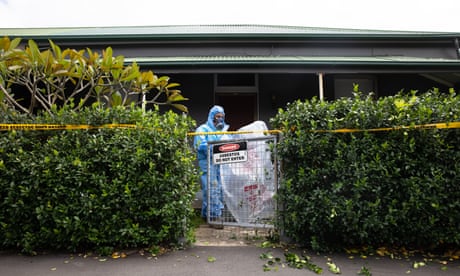- by foxnews
- 04 Jun 2025
‘Appalling’: Newcastle residents question response after wool store fire showers homes with asbestos
‘Appalling’: Newcastle residents question response after wool store fire showers homes with asbestos
- by theguardian
- 23 Mar 2022
- in news

Newcastle residents whose homes were showered in asbestos fragments and other materials after a massive warehouse fire in early March say they are dismayed by the New South Wales government's response to the disaster.
Three weeks after the fire broke out in an old wool store in the inner Newcastle suburb of Wickham, a primary school remains closed as authorities deal with the cleanup.
Frustrated residents in Wickham, Islington, Maryville and other nearby suburbs that fell under the smoke plume say they have had to push for assistance amid "appalling" communication from authorities.
Fire crews were called to the large blaze on Annie Street on 1 March. Thick smoke could be seen from nearby suburbs and the immediate concern for fire crews was the building's proximity to a number of fuel tanks so close to residential areas.
The fire was so ferocious it destroyed two wool stores at the site and caused the asbestos roofing of both warehouses to explode, scattering debris over homes and reaching more than three kilometres to the west.
Islington public school remains closed due to the contamination, and the top layer of grass and soil in some of its playgrounds has had to be dug up and removed.
Other public facilities, including a park and Tafe sites, have been intermittently closed for cleaning.
But residents say they have struggled to get clear information from authorities about what to do in their own homes, and aired their frustrations at two public meetings organised by the state Labor MP Tim Crakanthorp. Multiple attenders later described the response from officials as "defensive".
The Public Works Advisory has told residents that consistent air monitoring in the immediate and surrounding areas has returned negative results for airborne asbestos, "confirming that there is no airborne health risk", a spokesperson said.
Bronwyn McDonald is an Islington resident who works for the Wilderness Society. She lives with her partner, Max Menyhart, and two young children in a house that was showered with debris ranging "from the size of my fingertips to my palm and larger than my hand" on the day of the fire.
"There were chunks of asbestos that were fibrous, paint flecks, lots of charred debris and black and white dust," McDonald said. "It was everywhere, on the cars, on the footpath, our grass and plants, the veranda, the concrete area of the yard and the garden."
She said authorities appeared to have organised clean ups of public spaces, but the response in residential areas had been poorly coordinated and lacked clear communication about which government agency was in charge.
Residents learned through social media and word of mouth that they were required to report to the Environment Protection Authority if their home had been affected in order to organise a clean by public works.
Several were later sent a deed of release that asked them to acknowledge that Public Works Advisory and other NSW government agencies "have no legal liability for the presence of any asbestos in the property". The form also asked residents to agree that government authorities should not have to pay "claims, costs, losses, damages and liabilities".
McDonald and Menyhart organised a private clean of their home and briefly moved out but have since returned and will also have the home cleaned by public works.
"We've absolutely been worried every single day since this has happened," McDonald said. "I have concerns that my kids have incidentally inhaled asbestos.
"For me it's been hugely worrying that they're reacting in public spaces where they have legal responsibility but there's been very little response on whether we should be worried in our private residences."
McDonald said she was concerned for residents unaware they needed to formally request a clean, and for those who were renting. She was also worried vacant properties would be missed.
Menyhart door-knocked homes in their neighbourhood and found several people who did not know their properties required cleaning.
Will Sherman lives with his wife and six-year-old daughter on a street in Islington about 450 metres from the wool stores. He was driving his daughter home from school at the time of the fire.
"We got home and I thought it was hailing but that turned out to be chunks of asbestos and debris landing on our roof," he said.
Sherman said authorities had emphasised at the meetings that monitoring showed no airborne asbestos and that the recent heavy rain had helped suppress any fibres. But at the same time the school and parks had been closed and some people's green bins had been taped up and taken away.
"The level and type of communication has been appalling," he said. "Apart from concern about health issues, I feel really let down and extremely stressed."
The confusion for residents in the aftermath has been compounded by the fact that properties are being prioritised for cleaning in different ways.
Some buildings near the blast are being cleaned externally and internally. But residents who live further away, such as McDonald and Sherman, have been told only the exterior of their homes will be cleaned and this will not include the roof.
This has led to concern that fragments of asbestos that remain on the roofs will be dispersed when the wind picks up.
Kath Fielden is a solicitor who lives with her two teenage daughters on Lewis Street in Islington, about 300 metres from the wool stores. On the day of the fire, they were all at home with their windows and doors open for ventilation as her eldest daughter had Covid.
Fielden describes hearing a bang, followed by a rush of heat and fragments similar to coarse river sand.
"The next day I found five cent piece-sized particles of asbestos in the house," she said.
Fielden has registered for a clean but is angry it will exclude the interior of the home and the roof. "I feel anxious in my house."
Terry Slevin is the chief executive of the Public Health Association of Australia and previously chaired the Cancer Council Australia's occupational and environmental cancer committee.
He said asbestos disturbance caused by major emergencies such as fire and flood was common and it was "difficult to know with any precision" the level of health risk it created.
He said this was why it was crucial authorities provided clear information to residents.
"It's important that people don't think that if there is some presence of asbestos around their properties that it will automatically result in them or anyone in their family having an asbestos-related disease," Slevin said.
A spokesperson for Public Works Advisory said there had been a coordinated response for two weeks, including consistent air monitoring. They said the response was initially led by emergency services but the recovery phase was "being supported by [the] EPA and PWA in managing the clean up".
"The approach to clean-up has been guided [by] assessing the deposits of destroyed roof material found through extensive surveys of the neighbourhood and streets in the direction of the smoke plume," the spokesperson said.
The spokesperson said 392 people had registered as being affected and assessors had also door-knocked residents in areas near the fire. Of those registered, 200 properties had been assessed as requiring environmental cleaning, which had been now been completed at 183 of those properties.
The most exposed area included the adjacent apartment blocks where residents were evacuated, the spokesperson said. Those areas were being extensively cleaned.
The spokesperson said the deed of release document was to obtain the owner's permission for the clean and "clarify legal responsibilities".
- by foxnews
- descember 09, 2016
Should you lock your luggage when traveling? Why it's a weighty matter
With tightened security, experts are warning of luggage risks like theft and mishandling for travelers. TSA sees 90,000 to 100,000 items left at checkpoints monthly.
read more


